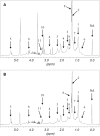(31)P and (1)h nuclear magnetic resonance spectroscopy of blood plasma in female patients with preeclampsia
- PMID: 23675281
- PMCID: PMC3615299
(31)P and (1)h nuclear magnetic resonance spectroscopy of blood plasma in female patients with preeclampsia
Abstract
Objective: Using (31)P and (1)H magnetic resonance spectroscopy to measure phosphorus- and hydrogen-containing metabolites, this study aimes to investigate whether or not women with preeclampsia have detectable systemic abnormalities concerning certain components of the blood plasma.
Methods: PLASMA WAS OBTAINED FROM TWO GROUPS OF WOMEN: Group 1 with preeclampsia (n=10) and Group 2, as a control group with no complications during pregnancy (n=10). Plasma analysis were performed using in-vitro (31)P and (1)H nuclear magnetic resonance spectroscopy.
Results: (31)P nuclear magnetic resonance (NMR) spectra showed significantly higher levels of lysophosphatidylcholine 1 in the plasma of the patients in Group 1, along with significantly decreased levels of lysophosphatidylcholine 2 and phosphatidylinositol. However, the total amount of phospholipids did not differ significantly between the groups. In addition, the (1)H NMR spectra showed a significantly lower level of HDL in samples from Group 1, and a trend towards higher plasma levels of VLDL 2 and LDL 2 in the same group.
Conclusion: This study supports the theory that preeclampsia is a disorder in phospholipid metabolism in which malfunctioning of cellular membranes seems to play a major pathogenic role.
Keywords: 31P and 1H-magnetic resonance spectroscopy; gestosis; lipid metabolism; preeclampsia.
Figures


Similar articles
-
Cerebral Magnesium Levels in Preeclampsia; A Phosphorus Magnetic Resonance Spectroscopy Study.Am J Hypertens. 2017 Jul 1;30(7):667-672. doi: 10.1093/ajh/hpx022. Am J Hypertens. 2017. PMID: 28338765
-
A 31P nuclear magnetic resonance investigation of acyl group transfer from phosphatidylcholine to yield lysophosphatidylcholine in human plasma.Lipids. 1994 Mar;29(3):183-8. doi: 10.1007/BF02536727. Lipids. 1994. PMID: 8170287
-
Plasma from women with preeclampsia has a low lipid and ketone body content--a nuclear magnetic resonance study.Hypertens Pregnancy. 2007;26(3):329-42. doi: 10.1080/10641950701436073. Hypertens Pregnancy. 2007. PMID: 17710581
-
[Progress in nuclear magnetic resonance spectroscopy for early cancer diagnosis].Guang Pu Xue Yu Guang Pu Fen Xi. 2008 Aug;28(8):1942-50. Guang Pu Xue Yu Guang Pu Fen Xi. 2008. PMID: 18975839 Review. Chinese.
-
31P magnetic resonance spectroscopy studies in schizophrenia.Prostaglandins Leukot Essent Fatty Acids. 1996 Aug;55(1-2):115-8. doi: 10.1016/s0952-3278(96)90155-6. Prostaglandins Leukot Essent Fatty Acids. 1996. PMID: 8888133 Review.
Cited by
-
Second trimester inflammatory and metabolic markers in women delivering preterm with and without preeclampsia.J Perinatol. 2019 Feb;39(2):314-320. doi: 10.1038/s41372-018-0275-8. Epub 2018 Dec 5. J Perinatol. 2019. PMID: 30518800 Free PMC article.
-
Integration of metabolomic and transcriptomic networks in pregnant women reveals biological pathways and predictive signatures associated with preeclampsia.Metabolomics. 2017 Jan;13(1):7. doi: 10.1007/s11306-016-1149-8. Epub 2016 Dec 12. Metabolomics. 2017. PMID: 28596717 Free PMC article.
-
A Non-Targeted LC-MS Profiling Reveals Elevated Levels of Carnitine Precursors and Trimethylated Compounds in the Cord Plasma of Pre-Eclamptic Infants.Sci Rep. 2018 Oct 2;8(1):14616. doi: 10.1038/s41598-018-32804-5. Sci Rep. 2018. PMID: 30279541 Free PMC article.
-
Applications of Metabolomics in the Study and Management of Preeclampsia; A Review of the Literature.Metabolomics. 2017 Jul;13(7):86. doi: 10.1007/s11306-017-1225-8. Epub 2017 Jun 12. Metabolomics. 2017. PMID: 30473646 Free PMC article.
-
Paired maternal and fetal metabolomics reveal a differential fingerprint in preeclampsia versus fetal growth restriction.Sci Rep. 2021 Jul 13;11(1):14422. doi: 10.1038/s41598-021-93936-9. Sci Rep. 2021. PMID: 34257400 Free PMC article.
References
-
- Chappell LC, Seed PT, Briley AL, et al. Effect of antioxidants on the occurrence of pre-eclampsia in women at increased risk: a randomised trial. Lancet. 1996;354(9181):810–816. - PubMed
-
- Weinstein L. Syndrome of hemolysis, elevated liver enzymes and low platelet count: a severe consequence of hypertension in pregnancy. Am. J. Obstet. Gynecol. 1982;142:159–167. - PubMed
-
- Vigil-De Gracia P. Pregnancy complicated by pre-eclampsia-eclampsia with HELLP syndrome. Int. J. Gynecol. Obstet. 2001;72:17–23. - PubMed
-
- Magann EF, Martin JN. Twelve steps to optimal management of HELLP syndrome. Clin. Obstet. Gynecol. 1999;42:532–541. - PubMed
-
- Wolf G, Wenzel U, Stahl RAK, Hüneke B. Hypertensive disorders in pregnancy (German) Med. Klin. 2001;96:78–86. - PubMed
LinkOut - more resources
Full Text Sources
Research Materials
